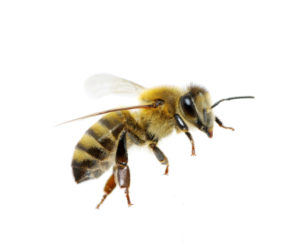 Bees use abstract thought and symbolic language.
Bees use abstract thought and symbolic language.
Bees routinely solve the advanced mathematical problem of the travelling salesman.
Bees mix medications for their hive and know when a fungus is dangerous.
Bees distinguish landscapes scenes, types of flowers, shapes and patterns.
Bees forage for information.
Bees learn categories, sequences, combinations, and the changes of future rewards.
All of these are accomplished by INDIVIDUAL bees, not hives.
How can such a small insect be able to think abstractly? Yet, this is exactly what a new study showed. Using concepts “above/below” and “difference” it demonstrated that bees can handle two different abstract concepts at the same time and make decisions based on these in new situations.
 How can bees visually distinguish landscape scenes, many types of flowers, many shapes and patterns with such a small visual brain? But, that is what recent research shows.
How can bees visually distinguish landscape scenes, many types of flowers, many shapes and patterns with such a small visual brain? But, that is what recent research shows.
Previous posts described the very complex symbolic language of the waggle dance, and bees’ remarkable ability to solve the advanced mathematical question of the shortest distance between many objects. Bees also distinguish dangerous fungi from harmless ones. They mix medicine called propolis and bring more when dangerous fungus infected their hive. When harmless spores were placed in the hive, the bees removed the spores but did not spread propolis. Bees, amazingly can remember route details up to six miles over several days.
How can we explain such remarkable cognitive capacities with a tiny brain?
The Bee’s Brain: Hardwired or Neuroplastic
Bees have approximately one million neurons in 0.5 mm; humans have 100 billion neurons. And yet bees can learn, and understand abstract concepts, 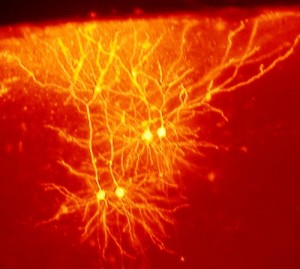 and make complex decisions.
and make complex decisions.
Observing humans rapid neuroplastic responses to experience, scientists have assumed that learning and plasticity depend upon the complexity of human brain. Most scientists have therefore assumed that advanced behavior in creatures with very small brains, such as the bee, must be “hard wired” rather than responsive and changeable.
While it is possible that some small-brained insects are hard wired, bees do not appear to be. Perhaps, this conclusion is based upon the much greater number of studies of the bees’ brain compared with other insects. It is possible that in the future other insects will be noted to have the neuronal changes of neuroplasticity.
While emphasis in the past has been on “hive” consciousness to explain some of the bees remarkable abilities, it is really not at all clear what hive or group intelligence is, or where it could reside. Our current understanding of bees greatly benefited from early research by Karl von Frisch who won a Nobel prize for  showing many facets of bees including seeing ultraviolet and polarized light, and communication with symbolic dances. Recent research on bees, shows neuroplasticity in individual neurons.
showing many facets of bees including seeing ultraviolet and polarized light, and communication with symbolic dances. Recent research on bees, shows neuroplasticity in individual neurons.
In fact, recent research convincingly demonstrates that individual bees are crucial for the functioning and decision making of the hive. The bee has individual memories related to experiences both in the hive and outside. Individual bees are able to evaluate timing of events, spatial arrangements and communication from other bees in comparison to their own personal experience.
Insect Nervous Systems
All insects have a brain and a series of neuron ganglia in the chest and abdomen. They have sensory nerves at two levels, that is, a sensory nerve going to a ganglia where there is a synapse then another neuron to the brain. Insects also have two layers of neurons for movement, a descending pre motor neurons, and motor neurons. There are also interneurons in the brain.
 The honeybee brain is highly structured in ordered groups of neurons with many of the central neurons individually identifiable. It has been shown that bees demonstrate plasticity in all the components of the olfactory learning and reward circuit.
The honeybee brain is highly structured in ordered groups of neurons with many of the central neurons individually identifiable. It has been shown that bees demonstrate plasticity in all the components of the olfactory learning and reward circuit.
The bee’s brain is large compared with other insects, (fruit flies being 50 times smaller with a tenth of the neurons). Bees have more elaborate visual systems and mushroom bodies, which perform integration of multiple senses. The mushroom bodies that integrate multiple senses are 20% of the brain volume with 200,000 neurons. (flies’ mushroom bodies consist of 2% of the brain volume with 2500 mainly smell neurons)
 The Virtual Atlas of the Honeybee Brain website shows the complexity of the bee brain with advanced central processing. Research has catalogued 40 different specific neurons. With advanced imaging it has been shown that one neuron can influence specific cognitive functions, mediating reward-based learning. This particular nerve VUMmx1 takes data from the antenna, the integrating mushroom body, and other lateral regions, learns about a new sucrose odor and an unpredicted reward. This type of neuron functioning resembles specific human dopamine neurons and shows advanced neuronal communication. This research has proven that bees’ brains have multiple different places for memory.
The Virtual Atlas of the Honeybee Brain website shows the complexity of the bee brain with advanced central processing. Research has catalogued 40 different specific neurons. With advanced imaging it has been shown that one neuron can influence specific cognitive functions, mediating reward-based learning. This particular nerve VUMmx1 takes data from the antenna, the integrating mushroom body, and other lateral regions, learns about a new sucrose odor and an unpredicted reward. This type of neuron functioning resembles specific human dopamine neurons and shows advanced neuronal communication. This research has proven that bees’ brains have multiple different places for memory.
Learning and memory
Despite attempts to consider bees in behaviorist terms, honeybee learning is much more complex than traditional classical and operant conditioning.
 The life of the honeybee is short, and the hive’s life is very long. Therefore, individual bees cannot be programmed to know locations, qualities of flowers and hive sites. Their observational learning is very advanced and beyond most other insects. Bees rapidly learn visual, smell, taste, and touch information in any foraging neighborhood. Bees are able to generalize about types of sites beyond simple categories. Visual information is not filtered but is part of the general central function of the brain. The bee is able to abstract from all of the sensory information.
The life of the honeybee is short, and the hive’s life is very long. Therefore, individual bees cannot be programmed to know locations, qualities of flowers and hive sites. Their observational learning is very advanced and beyond most other insects. Bees rapidly learn visual, smell, taste, and touch information in any foraging neighborhood. Bees are able to generalize about types of sites beyond simple categories. Visual information is not filtered but is part of the general central function of the brain. The bee is able to abstract from all of the sensory information.
It has been shown that bees take into account social conditions, time of day, location, and the different sensory stimuli and appear to show integrated memory of all of these characteristics. Bees are able to count scenes and therefore can remember the way through mazes and through complex outdoor scenes. This property has led scientists to consider that bees can count. Bees have demonstrated short-term memory in mazes and long term memory (several minutes) in rewards. Bees have also demonstrated memory over days, and their entire lifespan (weeks in summer bees and months in winter bees).
Interestingly, unlike other insects, honeybees use epigenetic methods for memory as mammals do. Both acetylation of histones, and methylation of  DNA are used in learning and memory consolidation. Scientists are just now trying to device RNA interference techniques to study the bee genome. Unfortunately, the techniques that have allowed close observation of how neuroplastic changes can occur in the fly have not been yet developed for the honeybee. Examples of this include the circuits of neurons that form lasting stronger synapses where learning is taking place.
DNA are used in learning and memory consolidation. Scientists are just now trying to device RNA interference techniques to study the bee genome. Unfortunately, the techniques that have allowed close observation of how neuroplastic changes can occur in the fly have not been yet developed for the honeybee. Examples of this include the circuits of neurons that form lasting stronger synapses where learning is taking place.
Neuroplastic changes (see post on How 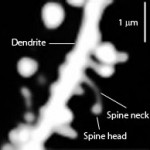 Neuroplasticity Works) have been observed for specific dendritic spine activity in the mushroom bodies during learning. The hundreds of thousands of mushroom body neurons synapse onto one hundred neurons, which then code the specific multi sensory learned stimulus combinations.
Neuroplasticity Works) have been observed for specific dendritic spine activity in the mushroom bodies during learning. The hundreds of thousands of mushroom body neurons synapse onto one hundred neurons, which then code the specific multi sensory learned stimulus combinations.
The mushroom body appears to act like a combination of the human hippocampus and the cortex changing sensory information into value based information. This advanced brain integration of the signals develops a memory over time, increasing ability to navigate in different situations as well as ongoing evaluation.
Aging in Bees
Sixty thousand workers are daughters of one queen. They seem to emerge without genetic predispositions, with very plastic abilities to adapt to different jobs. These adaptations often occur through epigenetic mechanisms of learning most often through smell.
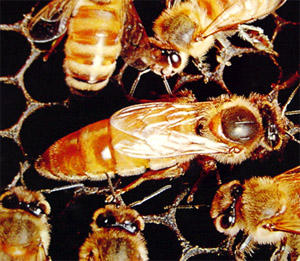
As bees age they have a cognitive decline and reduced ability to handle stress. Strangely, this aging is immediately reversed if the colony “swarms”, which is when the hive divides into two. Another way bees become young again is when young nurse bees are removed. Specific proteins have been identified related to this sudden ability of old bees to act young. Is this a fountain of youth for mammals as well? Intense research is now beginning on this question.
Winter bees do not have aging when they live for months without foraging. It appears that the demands of foraging are a stimulus to aging. Epigenetic changes are also involved in aging processes.
Food And Information Foragers
Most bees forage for food. A smaller group of bees are selected to forage for information as scouts, searching for new food regions and new nest sites. The queen is able to manipulate the choice of bees for these different tasks of caring for the young, scouting and food foraging through use of pheromones.
The democratic waggle dancing process uses a symbolic language for choosing a new nest has been described in a previous post where inhibitory signals have been found, much like those that occur with interneurons in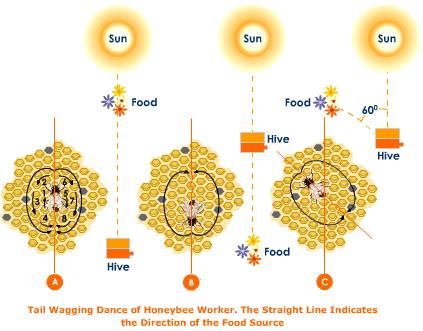 the human brain. The basis of this symbolic language and complex decision-making is not clear.
the human brain. The basis of this symbolic language and complex decision-making is not clear.
Communication for foraging occurs in the waggle language encoding distance, direction, and qualities of the available food or next site. The type of food is signaled by the odor on the dancing bee. Distance is described in the speed of the rounds of the dance; direction of the outbound flight relative to the sun is related to the angle of the waggle to gravity.
Other bees carefully observe the dance and learn from it. The information is integrated into specialized spatial memory to allow for new shortcuts to high quality flower targets. Bees start foraging near the hive, and then use the information to find more distance flowers. This advanced language of spatial locations doesn’t exist in any other animal.
 Before bees start foraging they first explore the region, examining the relation to the sun, spatial relations to landmarks, local conditions and the hive. Only then do they carry out extended trips for food. A young bee who has not previously experienced the specific new flower smell demonstrated in the waggle dance will leave early on and go to familiar sites looking for that new flower type. If that search is exhausted they will return to the waggle dance and learn how to fly to the new locations.
Before bees start foraging they first explore the region, examining the relation to the sun, spatial relations to landmarks, local conditions and the hive. Only then do they carry out extended trips for food. A young bee who has not previously experienced the specific new flower smell demonstrated in the waggle dance will leave early on and go to familiar sites looking for that new flower type. If that search is exhausted they will return to the waggle dance and learn how to fly to the new locations.
The bees are so capable in remembering locations that when they have exhausted their current location they remember short cuts to the new locations described in the waggle dance. Bees are able to remember a map of multiple locations, whereby they can navigate on the waggle information without knowing specific landmarks or visual scenes. In mammals some of this type of information exists in place grids and head direction cells in the hippocampus. How the bee can do this in their much smaller brain is not clear.
Conclusion
Bees demonstrate abstract thought, symbolic language, advanced visual perception, neuronal neuroplastic changes, decision-making, and planning. They learn through symbolic language and transfer these memories to specific spatial abilities including the ability to find the shortest distances between many different types of scenes and flowers. They can count, sequence, and combine concepts.
These capacities are in the individual bee, with a very small brain, one million neurons, versus humans 100 billion. This intelligence is in the individual bee not a mysterious “hive intelligence” (used to explain away their individual capacities) anymore than our intelligence is in the internet or society. With such advanced capacities in bees, as well as cognitive abilities in microbes, intelligence and mind in nature must be reconsidered.